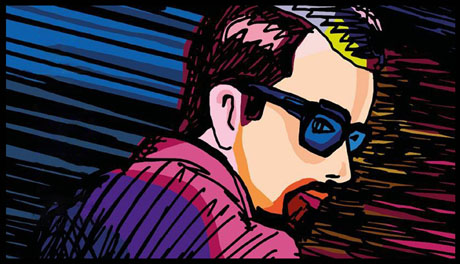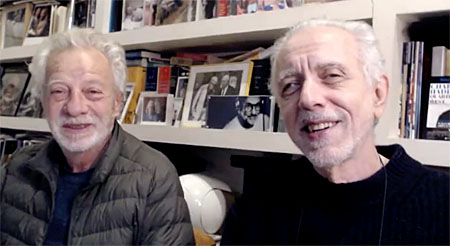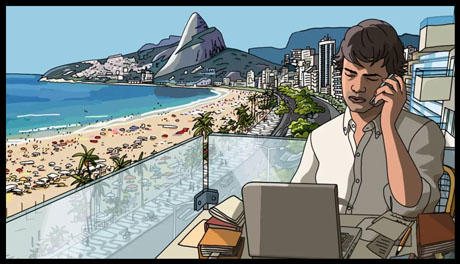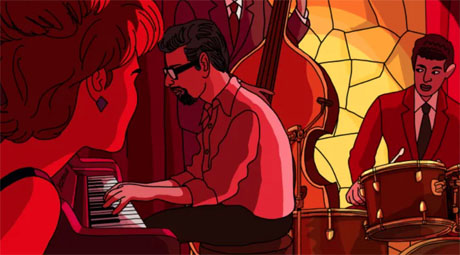
Academy Award nominated Chico & Rita directors Fernando Trueba and Javier Mariscal have made a new animated feature for grown-ups — a unique, moving investigation documentary drama. They Shot the Piano Player, starring Jeff Goldblum as the narrator and voice of journalist / author Jeff Harris, opens in New York City and Los Angeles for an awards qualifying run on November 24th. Sony Pictures Classics will then release it nationwide in early 2024. Trueba and Mariscal joined me from Spain on Zoom for this fascinating Animation Scoop Q&A. (This interview was edited for length and clarity.)
Jackson Murphy: I love the power this movie has and what it has to say about so much. Francisco Tenorio Jr. was a [real] Brazilian pianist who went missing in 1976, and this movie investigates what happened. Fernando, how did you want to approach this topic and, as a storyteller, share this story in the very unique ways that you do?
Fernando Trueba: In the very beginning… many years ago when I discovered Tenorio’s music and tragic end, I started to investigate and search for people who knew him. I spent a lot of time doing lots of interviews. I didn’t have a clear idea of what I wanted to do with it. I just wanted to know more about him. Once I stopped doing the interviews — I did a lot of them in Brazil and the United States (L.A., New York, Boston and Arizona), and some in Argentina — I was overwhelmed by all this material. It took me years, and also the experience of doing “Chico and Rita”, to realize there was an ideal language for telling this story, and it was animation. It took me years to make that decision and then when I finally had no doubts about it, I called my friend [Javier] Mariscal about the project, and that’s how it started.

Murphy: Amazing. You made it happen… into a great animated docu-drama. Javier, as far as animating the real interviews that were done — real people and real conversations — what were some of the challenges of drawing real people and translating these interviews to the screen?
Javier Mariscal: Thanks to Fernando, he brought me a lot of information. We have a great [outlet]. We don’t need to make it in a very realistic way. I thought it was best to make caricatures — make the faces and the hands a little bit big… and to bring in many photographs from the outside. We make an expression more unrealistic… because it’s much better. This is for an adult audience. We don’t need to make it like a real film. The drawing is always more synthetic and more expressionist like a caricature.
Trueba: This is an animation for grown up people. We didn’t want to treat them as children. The audience makes part of the job — they have to work in the movie. That was important for us.
Murphy: I agree with that completely. We go on this journey with our main character, author Jeff Harris, who’s talking about all of this [at a bookstore]. I love the framework, and Jeff Goldblum does a fantastic job.
Trueba: Working with Jeff is happiness. I love him as an actor and a person. He’s a musician too. He’s a great pianist. And he has the best voice. There are many incredible voices in American actors, but the quality of Jeff’s voice is that he’s like a jazz speaker. He’s always surprising. He’s always fresh, new and original. He’s never on the obvious path. He has a way to deliver every line that I like very much.

Javier Mariscal and Fernando Trueba
Murphy: Yes. He works as a great narrator, a great guide for us, and he expresses a lot of emotions really well, which really come through. I think in the final 30 to 40 minutes of the film especially, this is a celebration of journalism and how far a reporter will go. How does this theme speak to you?
Trueba: We wanted a more realistic approach to the contemporary part of Jeff’s investigation and his research. Our challenge was to put in colors and drawings… the memories of the characters — how to go into their different heads.
Mariscal: I think a lot about Jeff and his apartments. How is this character? How is the house? Which computer… how is the kitchen… how is he living? Does he have a bicycle? Does he live in a very normal apartment or in a loft? Every object, book, everything around defines the character. I tried to make it very singular to define the character. Thanks to all the objects, you understand much better how this character is. They are realistic. And the memory of the characters… it’s something we have inside, and can be completely different of the same event. This is more unrealistic and like a caricature… with their feelings and what they’re talking about.
Trueba: And when it comes to journalism, this is not a movie based on a book or an investigation. The movie is the investigation. For us, this was very interesting to do.
Mariscal: The real journalists, what they do is try to find the truth. I remember when I was in Rio de Janeiro for the opening [of this], the people of Rio say, “Thanks. Fernando and you helped me to know somebody from Rio we don’t know.” It’s like a gift. This was completely unknown there. And with animation, we give a life again to Tenorio. If it was with an actor all the time you’d say, “Uh, this actor tried to be Tenorio. If it’s a drawing: It’s Tenorio! He’s playing! He has a life.”

Murphy: This is a celebration of Tenorio — the music, Brazil, the nightlife. And I love the details in the rooms. What was the editing process like? I have to imagine it was challenging to place the interviews and show how you wanted to tell this story?
Trueba: There are two moments that we can call editing. One is writing the script. I have to go through this big mountain of interviews, taking notes and selecting the pieces I was going to use in the screenplay. And then obviously when we are working on the animatic and putting all the material together and making corrections — re-writing. In animation in a way, the writing and editing are closer than even in live-action movies. And we had a very strong story, and when you want to tell it and get people into it and understand it, the context is very important. In order to understand Tenorio and what happened to him, you have to know a bit about the musical moment Brazil was in the beginning of the ’60s. And what was the historical moment of Latin America in the ’70s? If you don’t have this historical context, you can’t really understand the story.
Mariscal: And Jeff is from the U.S.A. Frank Sinatra and many other musicians played the bossa nova. Never in Madrid. It’s not very realistic for a man from Madrid to make all the questions. What’s more realistic is a journalist from New York who’s very interested in this. “Why did Sinatra make a record with him?”
Trueba: And also the implication of the United States in politics in Latin America at the period. It made much more sense that this character is an American. A choice for better telling the story and making it more comprehensible.

Murphy: I love that he’s in Brazil, meeting his friend, working on something else, and then Tenorio becomes the story he has to tell. I got to see this movie on International Animation Day. After doing these two animated movies, what has amazed you about what animation can do?
Trueba: Javier is very familiar with the medium. He’s an illustrator and a painter. For me, it was a big discovery as a writer/director. I knew animation but I had not thought, before “Chico and Rita”, that I was going to work in the language of animation. It’s a pivotal language for certain types of stories. When you do a movie as live-action, a documentary or as animation, it must be for good, good reasons. You have to have powerful reasons. For me, I discovered the potential of animation for telling stories like this, where you have a musical component, a historical component, a real investigation. At the same time it’s a thriller… and a movie about memory. What is left of us when one day we disappear and if anyone tried to reconstruct the puzzle of someone’s life. Like Javier was saying… there is always a pact the audience makes with a movie. With animation, you really believe when they say, “This is Tenorio.” Not with an actor in costumes or makeup. In animation, you believe it in a different way. As a spectator, we accept it more, and it gives you an incredible freedom of possibilities.
Mariscal: Everything is symbolic. Money is just paper. But we say, “Okay. This is $5. Wow.” But it’s just a paper. The symbolism is more personal in the language of drawings. It’s more poetic. The relationship with the audience is stronger. “I believe this is a boat, but it’s not true. It’s not a boat.”
Trueba: So you mean money is animation?
Mariscal: No.
Trueba: Because you can draw the budget for the next movie. (laughs)
- INTERVIEW: Strap In For “Mars Express” - April 30, 2024
- INTERVIEW: Jeff Fowler On “Knuckles” And “Sonic 3” - April 22, 2024
- INTERVIEW: “Inside Out 2” Director And Producer On Pixar Sequel - April 16, 2024


 November 13th, 2023
November 13th, 2023  Jackson Murphy
Jackson Murphy  Posted in
Posted in  Tags:
Tags: 






